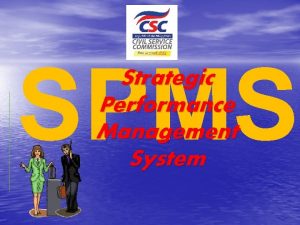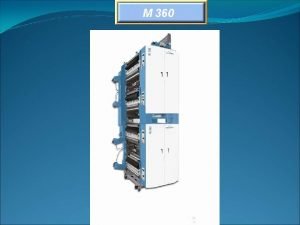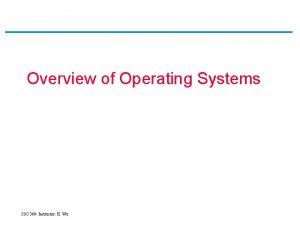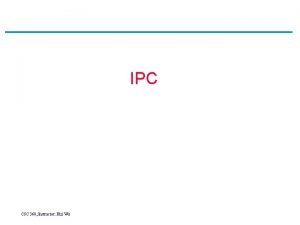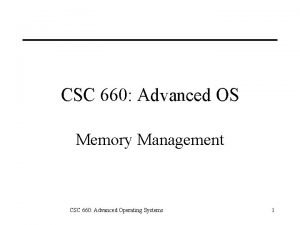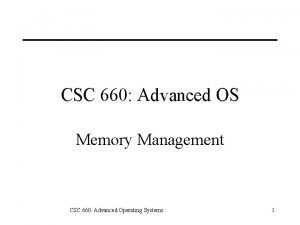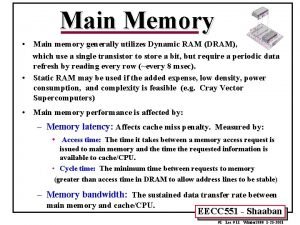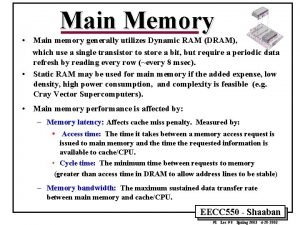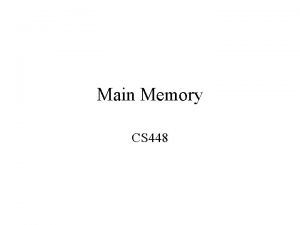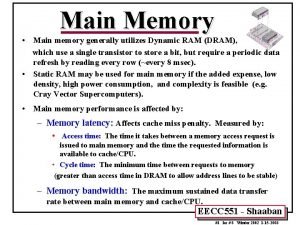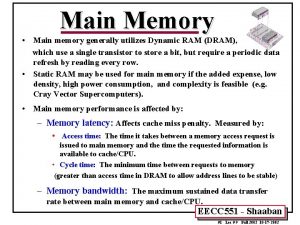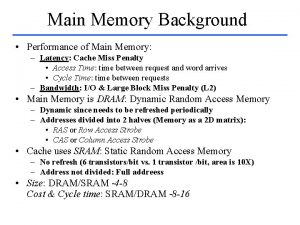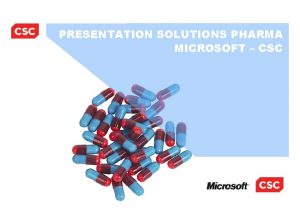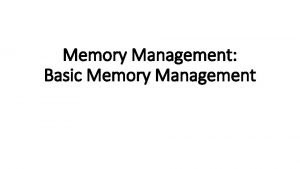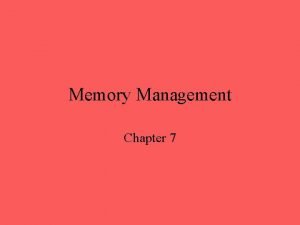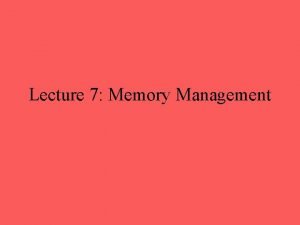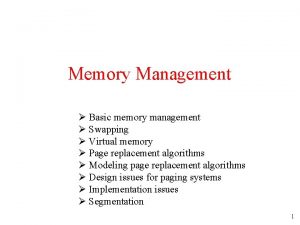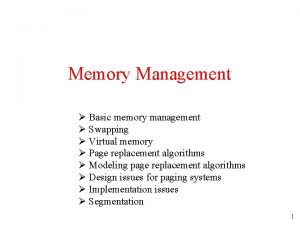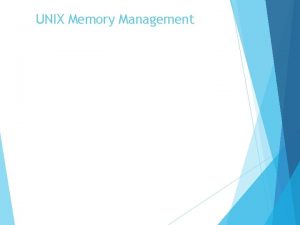Memory Management I Main Memory CSC 360 Instructor



























- Slides: 27

Memory Management I: Main Memory CSC 360, Instructor Kui Wu

Agenda 1. Background 2. Swapping 3. Continuous Memory Allocation 4. Paging 5. Segmentation CSC 360, Instructor Kui Wu

1. Background (1): Storage hierarchy CPU direct access • registers • (main) memory – cache CSC 360, Instructor Kui Wu CSc 360 2

1. Background (2): Memory access Access by address • for both code and data Address binding • compiler time: absolute code – MS-DOS. COM format, 64 KB limit • load time: relocatable code – MS-DOS. EXE format • execution time CSC 360, Instructor Kui Wu CSc 360 3

1. Background (3): Memory space Logical memory • seen by CPU • virtual memory Physical memory • seen by memory unit Address binding • compile/load time: logical/physical addr same • execution time: logical/physical address differ CSC 360, Instructor Kui Wu CSc 360 4

1. Background (4): Memory management MMU: memory management unit • logical/physical memory mapping Relocation register • physical address = logical address + relocation base Dynamic loading Dynamic linking CSC 360, Instructor Kui Wu CSc 360 5

1. Background (5): Memory protection With base and limit registers physical With limit and relocation registers CSC 360, Instructor Kui Wu CSc 360 6

2. Swapping Swap out • e. g. , low priority • reduce the degree of multiprogramming Swap in • address binding Swapping overhead • on-demand CSC 360, Instructor Kui Wu CSc 360 7

3. Contiguous Memory Allocation (1) Single-partition allocation • one for OS • the other one for user process Multi-partition allocation OS OS process 5 process 9 process 8 process 2 CSC 360, Instructor Kui Wu process 10 process 2 CSc 360 process 2 8

3. Contiguous Memory Allocation (2): Partition allocation First-fit • first “hole” big enough to hold • faster search Best-fit • smallest “hole” big enough to hold Worst-fit • largest “hole” big enough to hold CSC 360, Instructor Kui Wu CSc 360 9

3. Contiguous Memory Allocation (3): Fragmentation External fragmentation • enough total available size, not individual ones Compaction • combine all free partitions together • possible if dynamic allocation at execution time • issues with I/O (e. g. , DMA) Internal fragmentation • difference between allocated and request size CSC 360, Instructor Kui Wu CSc 360 10

4. Paging (1) Noncontiguous allocation • in fixed size pages • page size: normally 512 B ~ 8 KB Fragmentation • no external fragmentation – unless there is no free page • still have internal fragmentation – maximum: page_size - 1 CSC 360, Instructor Kui Wu CSc 360 11

4. Paging (2): Supporting paging Access by address • seen by CPU – logical page number – page offset – “frame” • seen by memory – physical page number – page offset Page-table registers • one more memory access CSC 360, Instructor Kui Wu CSc 360 12

4. Paging (3): Supporting paging: more TLB • translation look-aside buffer • associative Access by content • if hit, output frame # • otherwise, check page table CSC 360, Instructor Kui Wu CSc 360 13

4. Paging (4): Page table CSC 360, Instructor Kui Wu CSc 360 14

4. Paging (5): Paging example CSC 360, Instructor Kui Wu CSc 360 15

4. Paging (6): Page table with TLB Translation Look-aside Buffer (TLB) • associative memory CSC 360, Instructor Kui Wu CSc 360 16

4. Paging (7): Page table: valid bit CSC 360, Instructor Kui Wu CSc 360 17

4. Paging (8): Shared pages Shared code • one read-only code • same address in logical space Private code + data • one copy per process CSC 360, Instructor Kui Wu CSc 360 18

4. Paging (9): Hierarchical page table Difficulty with a table of too many entries • where to keep the table • how to lookup efficiently Solution • e. g. , 2 -level table CSC 360, Instructor Kui Wu CSc 360 19

4. Paging (10): Hash page table Hash + linked list CSC 360, Instructor Kui Wu CSc 360 20

4. Paging (11): Inverted page table When • physical space << logical space Tradeoff • time • space CSC 360, Instructor Kui Wu CSc 360 21

5. Segmentation (1): User's view of a program A collection of segments • main program • symbol table • procedures/functions • data • stacks • heaps CSC 360, Instructor Kui Wu CSc 360 22

5. Segmentation (2): Logical view of segmentation 1 4 1 2 3 2 4 3 user space CSC 360, Instructor Kui Wu physical memory space CSc 360 23

5. Segmentation (3): Segmentation Architecture • Logical address consists of a two tuple: <segment-number, offset>, • Segment table – maps two-dimensional physical addresses; each table entry has: – base – contains the starting physical address where the segments reside in memory – limit – specifies the length of the segment • Segment-table base register (STBR) points to the segment table’s location in memory • Segment-table length register (STLR) indicates number of segments used by a program; segment number s is legal if s < STLR CSC 360, Instructor Kui Wu CSc 360 24

5. Segmentation (4): Segment table CSC 360, Instructor Kui Wu CSc 360 25

5. Segmentation (5): Example of segmenting CSC 360, Instructor Kui Wu CSc 360 26
 Ipcr comments
Ipcr comments Tipología de los participantes
Tipología de los participantes Basic instructor course texas
Basic instructor course texas Basic instructor course texas
Basic instructor course texas Basic instructor course #1014
Basic instructor course #1014 Pepperball hotshot
Pepperball hotshot Neither of my two suitcases are adequate for this trip
Neither of my two suitcases are adequate for this trip Instructor vs teacher
Instructor vs teacher Cisco certified instructor
Cisco certified instructor Mptc instructor
Mptc instructor Basic instructor course texas
Basic instructor course texas Basic instructor course texas
Basic instructor course texas Drawing and painting the virtual instructor
Drawing and painting the virtual instructor Nfpa 1403 instructor to student ratio
Nfpa 1403 instructor to student ratio Human factors instructor
Human factors instructor Instructor operating station
Instructor operating station Catia instructor
Catia instructor Instructor
Instructor Instructor responsibilities and professionalism lesson plan
Instructor responsibilities and professionalism lesson plan Tcole 1014 basic instructor course
Tcole 1014 basic instructor course Jrotc marksmanship instructor course online
Jrotc marksmanship instructor course online Nrp instructor toolkit
Nrp instructor toolkit Cisco instructor certification
Cisco instructor certification Wisconsin registry cbrf
Wisconsin registry cbrf Nra certified instructor logo
Nra certified instructor logo Naismith was an instructor of
Naismith was an instructor of Please clean your room
Please clean your room Tcole advanced instructor course
Tcole advanced instructor course
